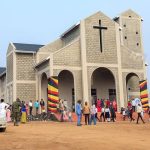Among the Bamasaba, candidates preparing for circumcision or incision wear specific cultural paraphernalia as they transition from boyhood to manhood. The final stage of this transition involves the removal of the candidate’s foreskin, marking their entry into manhood after successfully undergoing this rigorous cultural ritual.
Among the Maasai of Kenya and Tanzania, circumcision is highly esteemed to the point that children cannot address their fathers as “Daddy” unless they themselves are circumcised.
However, the cultural dress for the circumcision ceremony may vary within Masabaland. People in Namisindwa might wear different cultural items compared to those in Bududa, Bungokho, or Sironko.
Wearing Bells: Candidates may wear bells on their thighs, usually six on each thigh, though this can vary based on the size of the candidate. Older candidates for Imbalu might wear up to eight bells on each thigh.
Hand Bells: These are typically worn by people in South Bugisu, particularly in Bumbo and Bubutu areas. They serve as an alternative to the bells worn by Imbalu candidates in Bududa and Sironko. Candidates from Bumbo and parts of Kenya, who traditionally circumcise younger boys (about 14 years old or younger), may not manage the heavier thigh bells.
Short Trousers: These are part of the wardrobe for an Imbalu novice. They allow the candidate to move freely across hills and other terrains while entertaining supporters with traditional songs and vowing to be like his father.
Wearing the Bolt: This is a well-decorated item with cowrie shells and is highly symbolic in Bamasaba culture. It enhances the candidate’s appearance.
Wearing Large Wooden Rings: Known locally as “tsimboko,” these rings are worn on both elbows. They can be dangerous if used roughly during Imbalu competitions. Candidates are cautioned to use them responsibly, as rough use could lead to serious injuries or even death.
Head Gear: Made from Colobus monkey skin and adorned with cowrie beads, this headgear is significant because the Bamasaba only wear items from animals they consume. About 90% of Bamasaba people eat monkeys.
Wearing Beads: Beads are used to enhance the beauty of the candidates and may vary from person to person. Some items mentioned may not be easily procured by everyone, and not all candidates are required to wear all these items to be circumcised.
Wearing Hippopotamus Bone: This item is artistically designed and semi-circular, resembling the number seven. It is worn on the forehead of the Imbalu candidate.
The significance of these cultural items is to enhance the candidate’s appearance and signify that the Bamasaba eat certain animals, such as monkeys, baboons, and Colobus monkeys.
During the actual circumcision, the candidate must stand firmly without flinching, with oral marks potentially awarded up to 100%.
Behind the Scenes Information During Imbalu
On the day of the Imbalu ceremony, candidates in some districts, like Sironko and partly Bulambuli, may smear red pepper and ash on their manhood. After the first cut, candidates insert ash into their penis, which earns them high cultural marks.
Excretion of Fecal Matter on the Traditional Circumciser: Some candidates may find it hard to endure the pain and might end up defecating on the surgeon. This has several consequences: the candidate will be restrained with ropes for proper circumcision, and even the most severe actions by elders cannot prevent completion of the ritual. Beating the candidate may also be part of the process to ensure they finish the ritual. It is impossible to pay or escape the Bamasaba circumcision ritual.
Additionally, if a candidate defecates on the surgeon, they may have to provide goats or cash as compensation. The amount of compensation correlates with the amount of feces. Such a circumcision venue may be abandoned in subsequent Imbalu celebrations.
Overall, Imbalu is celebrated peacefully, and 99% of candidates complete the ceremony without the described incidents. This exposition aims to demonstrate that Imbalu is more than just a simple ritual; it is a deeply rooted cultural practice that explains why the Bamasaba are the only circumcising Bantu tribe in the eastern region of the country. Other tribes, like the Banyole, Bagwere, Basoga, and Basamia, might view circumcision differently or even avoid it altogether.
Mr. Steven Masiga is the spokesperson for Inzu ya Masaba




















